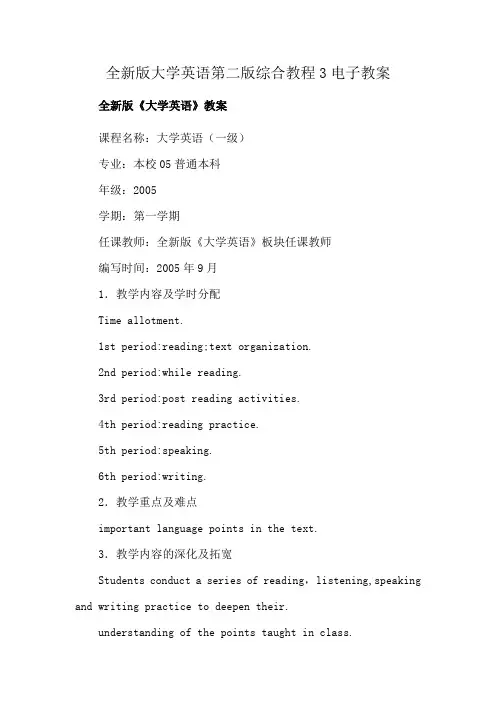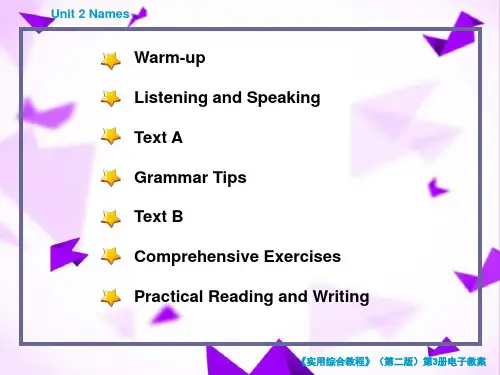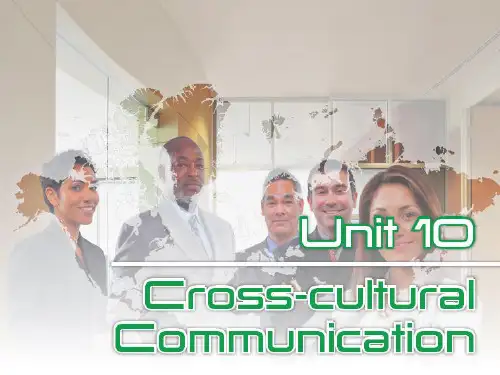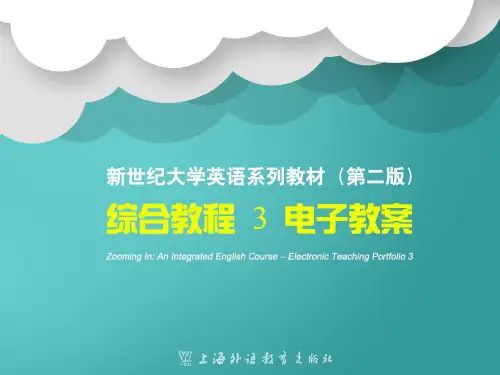实用综合教程3(第二版) 电子教案U
- 格式:ppt
- 大小:18.23 MB
- 文档页数:243


全新版大学英语第二版综合教程3电子教案全新版《大学英语》教案课程名称:大学英语(一级)专业:本校05普通本科年级:2005学期:第一学期任课教师:全新版《大学英语》板块任课教师编写时间:2005年9月1.教学内容及学时分配Time allotment.1st period:reading;text organization.2nd period:while reading.3rd period:post reading activities.4th period:reading practice.5th period:speaking.6th period:writing.2.教学重点及难点important language points in the text.3.教学内容的深化及拓宽Students conduct a series of reading,listening,speaking and writing practice to deepen their.understanding of the points taught in class.4.教学方式及在教学中应注意的问题A combination of traditional teaching methods with the communicative approach will be adopted.Special attention should be paid to classroom interaction.Give students time to adapt to the new teaching mode in the university that are quite different from the one they were used to in the middle school.More encouragement is needed and more guidance will be given to them in their extracurricular study.。









ContentsUnit 8 CloningBefore Reading>> Word Web (2)>> Warm-up Questions (2)>> Test Your Knowledge on Cloning (2)>> Listening Comprehension (3)>> Background Information (3)Global Reading>> Part Division of the Text (5)>> Further Understanding (5)Detailed Reading (7)After Reading>> Useful Expressions (15)>> Sentence Translation (15)>> Compound Dictation (16)>> Oral Summary (16)>> Writing Practice (17)>> Talk about the Pictures (18)>> Proverbs and Quotations (18)Supplementary Reading>> Culture Notes (19)>> Reading (19)>> Comprehension Tasks (22)Before Reading >> Word WebWhat words or expressions will occur t o you whenever we mention “cloning”? Write down as many words and phrases as possible.identical unethical embryo replicatehorrifying reproductive scientist stem cellrisk Dolly, the sheep human cloning genedisputable cure disease organ scientific advancesci-fi film organBefore Reading >> Warm-up Questions1. What is cloning? Are there different types of cloning?2. How can cloning technologies be used?3. What animals have been cloned so far, and for what purpose?4. Can organs be cloned for use in transplants? If so, give examples.5. What are the risks of cloning?6. Should humans be cloned?Before Reading >> Test Your Knowledge on Cloning1. The concept of “cloning” was originally a science fiction idea. (F)(=Cloning was not originally a sci-fi idea although sci-fi writers have enjoyed playing about with the concept. Clones have always occurred in nature.)2. “Clone” comes from the ancient Greek word meaning “trouble”. (F)(=The word “clone” comes from the ancient Greek word meaning “twig” i.e., a division from the main branch.)3. One cell could theoretically launch a thousand clones. (T)(=It takes a whole cell to start a clone —but of course there’re millions of genetically identical cells in an animal organ.)4. Dolly the sheep was grown in a test-tube. (F)(=Although the cloning process takes place in lab conditions, the embryo has to be transferred into a surrogate mother to develop into a whole animal.)5. Cloned animals have the same personality as their “parent”. (F)(=Cloned animals may or may not have the same personality as their parent —personality is partly determined by the environment.)6. If you cloned yourself — the clone would be the same age as you are. (F)(=If you cloned yourself, the clone would begin like any other baby as a single-celled organism and take nine months before it was born.)Before Reading >> Listening ComprehensionListen to the passage about animal cloning and answer the questions.tadpole: 蝌蚪somatic: 身体的,体壁的embryonic: 胚胎的strip: 剥去gaur: 野牛traumatic: 创伤的1. When was the first animal cloned?(=In 1952.)2. How were clones created before the creation of Dolly?(=They were created from embryonic cells.)3. What is the technology used in cloning the animals?(=Nuclear transfer technology.)4. Can all species be cloned? Why?(=No. Because some species may be more resistant to somatic cell nuclear transfer.)Script:Scientists have been cloning animals for many years. In 1952, the first animal, a tadpole, was cloned. Before the creation of Dolly, the first mammal cloned from the cell of an adult animal, clones were created from embryonic cells. Since Dolly, researchers have cloned a number of large and small animals including sheep, goats, cows, mice, pigs, cats, rabbits, and a gaur. All these clones were created using nuclear transfer technology.Hundreds of cloned animals exist today, but the number of different species is limited. Attempts at cloning certain species have been unsuccessful. Some species may be more resistant to somatic cell nuclear transfer than others. The process of stripping the nucleus from an egg cell and replacing it with the nucleus of a donor cell is a traumatic one, and improvements in cloning technologies may be needed before many species can be cloned successfully.Before Reading >> Background InformationI. Cloning(Cloning describes the processes used to create an exact genetic replica of another cell, tissue or organism. The copied material, which has the same genetic makeup as the original, is referred to as a clone. The most famous clone was a Scottish sheep named Dolly.II. Hwang Woo-Suk✧ a South Korean veterinarian researcher✧ a professor of theriogenology and biotechnology at Seoul National University (dismissed onMarch 20, 2006)✧infamous for fabricating a series of experiments in the field of stem cell researchScript:Hwang Woo-Suk was considered one of the pioneering experts in the field of stem cell research until November 2005, best known for two articles published in the journal Science in 2004 and 2005 where he fraudulently reported to have succeeded in creating human embryonic stem cells by cloning. Both papers were later editorially retracted after they were found to contain a large amount of fabricated data.III. Stemagen✧ a corporation headed by Dr. Samuel Wood✧notable for cloning adult skin cells✧It successfully created the first 5 mature human embryos using DNA from adult skin cells. (视频略)IV. Dolly(视频略)V. The Pope(视频略)✧the Bishop of Rome✧the leader of the worldwide Catholic Church✧head of state of Vatican City✧The current pope (as in 2010) is Pope Benedict XVI, elected April 19, 2005 in papalconclave.Global Reading >> Part Division of the TextGlobal Reading >> Further UnderstandingI. For Part 1 True or False1. When Hwang Woo-Suk reported his success in creating human embryonic stem cells by cloning, people felt they were cheated. (F)(=When Hwang Woo-Suk reported his success in creating human embryonic stem cells by cloning, people felt very excited.)2. A lot of diseases would be treated if human embryonic stem cells can really be created by cloning. (T)3. Dr. Wood has a profound love for his mother. (T)4. Dr. Wood decided to do something for his mother when she developed diabetes. (F)(=Dr. Wood decided to do something for his mother at her funeral.)5. The other founder of Stemagen, the stem research company, also lost his father to diabetes. (F) (=The other founder of Stemagen, the stem research company, lost his father to ALS.)6. As his mother had diabetes, Dr. Wood thought it was rather ordinary to see his mother lose her eyesight and most of her ability to walk. (F)(=It was absolutely horrifying for Dr. Wood to see his mother lose her eyesight and most of her ability to walk.)I. For Part 2i. Table Completionii. Multiple Choice1. What are the researchers interested in? (=C)A. Cloning genes.B. Helping the sick.C. Creating disease-specific and person-specific stem cell lines.D. Putting a human face on cloning.2. What is Dr. Wood referred to as? (=D)A. The man to clone Dolly.B. The first man to clone human embryonic stem cells.C. The first man to cure diabetes.D. The first man to “clone himself”.3. What has led to the firestorm of controversy? (=A)A. Humanizing cloning.B. Providing a roadmap.C. Serving the purpose of helping the patients.D. A woman donating an egg.4. Why were people skeptical about their achievement? (=C)A. Because it’s impossible to clone blastocyst nowadays.B. Because the cell had been destroyed.C. Because some scientists cheated the public in the past.D. Because the researchers couldn’t prove the embryos were clones.II. For Part 3 Blank Filling1.To Dr. Wood, it’s an honor to be condemned by the Vatican and President Bush in the same week.2.Researchers in the embryonic stem cell field and their opponents usually have no dialogue.3.To give an embryo all the rights of a human life doesn’t make sense to Dr. Wood.Detailed ReadingI. Difficult Sentences1.Sadly, she developed complications related to diabetes. When she lost her eyesight andmost of her ability to walk, it was absolutely horrifying for me.1) What does “complications” specifically refer to?(=It refers to the diseases derived from diabetes, like the loss of eyesight and being unable to move.)2) Translate these sentences into Chinese.(=不幸的是,她患上了糖尿病引起的并发症。